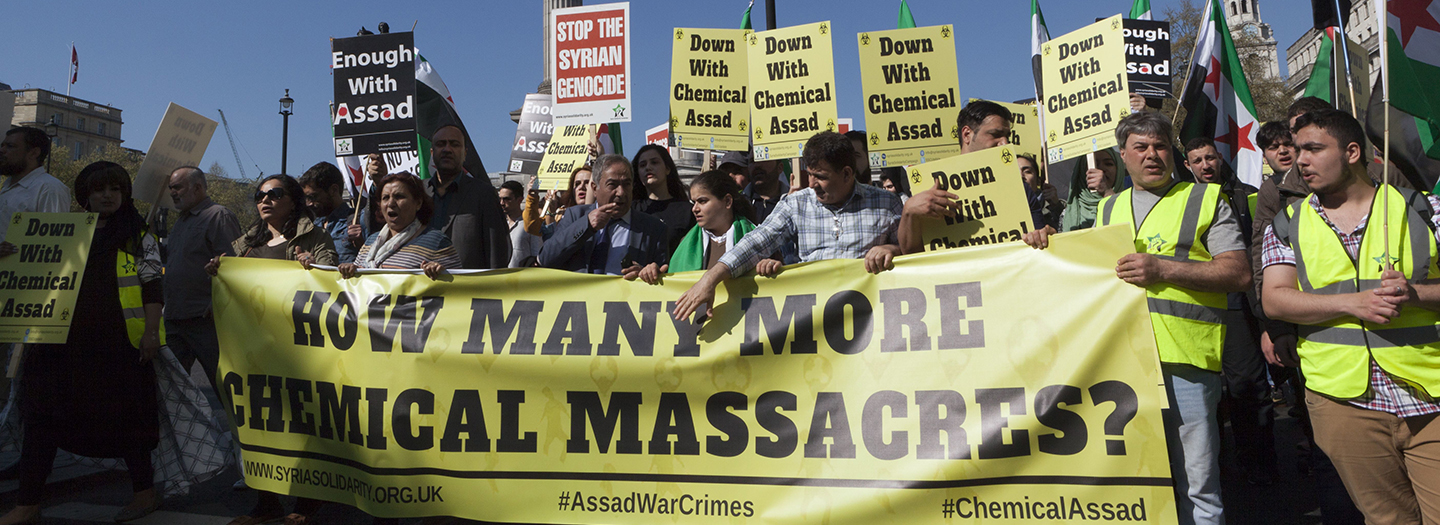
Rex Features via AP Images
On April 4, 2017, at least eighty-eight men, women, and children were killed in a chemical weapons attack in Syria. They were living in a region known to be inhabited by rebel forces seeking to overthrow the regime of Syrian President Bashar al-Assad. Autopsy results of three victims suggest that the banned chemical agent sarin was their cause of death.
Two days later, the United States launched a military strike on the Shayrat military airfield used by Syrian forces to stage the attack. Fifty-nine US Tomahawk Cruise missiles struck the airfield at 8:45 PM EST, 3:45 AM Friday in Syria.
President Trump explained his decision: “It is in this vital national security of the United States to prevent and deter the spread and use of deadly chemical weapons.” He added: “There can be no dispute that Syria used banned chemical weapons, violated its obligations under the Chemical Weapons Convention and ignored the urging of the UN Security Council. Years of previous attempts at changing Assad’s behavior have all failed and failed very dramatically.”
Syria’s six-year civil war has claimed the lives of at least 400,000, according to a United Nations estimate released a year ago. More than five million Syrians have fled the country and more than six million more have been displaced internally, according to UN agencies.
The air strikes are the first direct military action the US has taken against Assad’s leadership in his country’s civil war. They represent a substantial escalation of America’s military engagement in the region.
Why is Syria at war? What is likely to come next? What biblical principles are relevant to this escalating conflict?
A brief history of Syria
Syria is about the same size as the state of Washington and is home to a population of twenty-two million people. The country is very diverse ethnically and religiously, but most Syrians are ethnic Arabs who follow the Sunni branch of Islam.
The present-day country is only a small portion of the ancient geographical Syrian landmass, a region situated at the eastern end of the Mediterranean Sea. Western powers created the contemporary countries of Syria, Lebanon, Jordan, and Israel in the post-Ottoman era of the early twentieth century. Greater Syria is a region connecting three continents, functioning as a crossroads for commerce and a battleground for the political destinies of dynasties and empires.
Archaeologists believe the original civilization in Syria was one of the most ancient on earth. As part of the Fertile Crescent, with some of the earliest cattle breeding and agriculture in history, the land is filled with archaeological remains. Syria is home to Ebla, one of the oldest cities ever excavated. The city is believed to have been established around 3,000 BC. Its inhabitants developed one of the oldest known written languages.
This sought-after land was occupied by a variety of ancient empires—the Egyptians, Hittites, Sumerians, Mitanni, Assyrians, Babylonians, Canaanites, Phoenicians, Arameans, Amorites, and Persians. The Greeks eventually conquered the land under Alexander the Great (“Syria” means “formerly Assyria” in ancient Greek). Several hundred years later, Pompey the Great captured the Greek capital of Antioch (now part of Turkey, but once in Syria), turning it into a Roman province.
Syria was significantly important in early Christian history. Paul was converted on the road to Damascus and was a leading figure at the local church in Syrian Antioch, where followers of Jesus were first called Christians (Acts 11:26).
When the Roman Empire fell into decline, Syria became part of the eastern half, better known as the Byzantine Empire, around AD 395. The country was conquered by Muslim Arabs at the Siege of Damascus in 634.
In the eighth century, conflict began between the Hamdanids, Byzantines, and Fatimids, all of whom wanted to rule the area. The Byzantines eventually won control of the region. Syria was later conquered by the Seljuk Turks and then the Ayyubid dynasty of Egypt in 1185. In 1516, Syria was conquered by the Ottoman Empire and remained part of the Empire until its collapse in 1918.
In 1916, the Sykes-Picot Agreement secretly divided the Ottoman Empire into zones. In 1918, when Arab and British troops captured Damascus and Aleppo, Syria became a League of Nations mandate and moved under French control in 1920.
A revolt broke out among a large number of Syrians in 1925 due to the unpopularity of the French Mandate. The revolt spread into Lebanon but was suppressed in 1926. In 1928, elections were held for a constituent assembly that included a Syrian constitution, but France rejected the elections, leading to more protests.
France and Syria negotiated a treaty of independence in 1936, allowing Syria to maintain independent even though France held military and economic dominance. But the French never ratified the treaty, and when they became involved in World War II, Syria was briefly held by Vichy France (Axis-controlled) until the British occupied the land in 1941.
By 1944, Syria was finally recognized as an independent republic. The French military left in 1946. On April 17, 1946, Syria gained its official independence but lacked stability internally, rotating between twenty different cabinets and four constitutions until the late 1950s.
Syria’s power was rooted in its military rather than its parliament. During the Suez Crisis in 1956, Syria signed a pact with the Soviet Union, allowing Russian political engagement in exchange for military equipment. Syria also moved closer to Egypt due to their shared socialist commitments.
Egypt and Syria merged in 1958 to become the United Arab Republic. In 1961, Syria broke this arrangement due to Egypt’s dominance and formed the Syrian Arab Republic. Most of the 1960s were characterized by coups, military revolts, bloody riots, and other civil disorders.
The Assad regimes
In 1970, the Syrian Minister of Defense, Hafez al-Assad, seized power in a bloodless coup. He became President in 1971. Assad wrote a new constitution, consolidated political parties, created a new legislature and local councils to govern smaller provinces, and declared Syria a secular socialist state with Islam as the majority religion.
Assad repressed open dissent. There was an assassination attempt In 1980. In 1982, Assad attacked the Muslim Brotherhood in what is known as the Hama Massacre; 20,000 to 40,000 civilians were killed or wounded by artillery fire.
By 1990, Syria joined the US-led coalition against Iraq, a decision that led to improved relations with the US. When Hafez al-Assad died in 2000, his son Bashar became his successor at the age of thirty-four. (The mandatory minimum age to be president was forty, a statute that was quickly revised at Hafez al-Assad’s death.) His son received 97.3 percent of the vote.
Bashar al-Assad began his regime peacefully, releasing 600 political prisoners and welcoming the visit of Pope John Paul II. However, a year later he began repressing reform movements and arresting intellectual leaders. In 2002, the US officially accused the Assad regime of acquiring weapons of mass destruction and included his country in their “axis of evil.” Syria was also accused of orchestrating the assassination of Lebanese Prime Minister Rafic Hariri in 2005.
International relations improved when Assad met with French President Sarkozy and Lebanese President Sulieman in 2008. He also hosted a summit with Turkey and Qatar to seek peace in the Middle East. In 2009, the US sent a special envoy to negotiate peace talks and posted its first ambassador to Syria in five years.
The next year, however, the US accused Syria of supporting terrorism groups such as Hamas, Hezbollah, and al Qaeda and renewed economic sanctions against the country. The UN joined these sanctions the next year. The Arab Spring in Egypt and Tunisia led to challenges against Assad in 2011. His government reportedly responded by kidnapping, raping, torturing, and executing activists and their family members. When Syrian troops opened fire on civilian protests, the civilians started shooting back.
There are two theories for the continued violence in Syria.
The first is “sectarian re-balancing.” This approach notes that Syria has artificial borders that were created by European colonial powers, forcing diverse religious and ethnic groups to live together. These colonial powers also tended to promote a minority and rule through it, worsening preexisting sectarian tensions.
According to Fareed Zakaria, we’re seeing the inevitable re-balancing of power along ethnic and religious lines. He likens the situation to Iraq after the US toppled Saddam Hussein. A long-oppressed majority then retook power from, and violently punished, the former minority rulers.
Most Syrians are Sunni Arabs, but their country is run by members of a minority sect known as Alawites (ethnic Arabs who follow a smaller branch of Islam). The Alawite government, led by Assad, rules through a repressive dictatorship that gives Alawites special privileges. As a result, some Sunnis and other groups hate the Alawites. By contrast, the Alawites fear that they’ll be crushed if Assad falls.
The second theory is Machiavellian in nature. It views the Assad regime as unsustainable and sees the violence there as the government’s way of staying in power. As we noted, Hafez al-Assad seized power in a coup after two decades of extreme political instability. His government was the result of siding with the Russians and aligning against the West.
Russia is no longer the economic or military force it once was. Nor is the West seen by most Syrians as the enemy it was once considered to be. Yet Bashar al-Assad has continued his father’s repression of his people as he seeks to maintain power.
Players in the current conflict
Russia is Syria’s most important ally, with ties that date to the Cold War. The Russians have a naval installation in Syria, their last foreign military base outside the former Soviet Union.
With a permanent seat on the the United Nations Security Council, Russia blocks most resolutions that might hurt the Assad regime. This is why the US often works around the UN to engage issues in Syria. Russia also has a financial stake in Syria as the result of significant weapons sales to the country.
Russian President Putin quickly issued a statement condemning the April 6 missile strike. He claimed that his government had already removed Syria’s chemical weapons and blamed the gas attack of April 4 on forces fighting the Assad regime. By contrast, the US Secretary of State claimed that the Russians “failed in their responsibility” with regard to Syria’s chemical weapons and are either incompetent or complicit on this issue.
Iran is engaged on the side of the Assad regime as well. It views Israel as a threat and uses Syria as a pathway for arming the militant group Hezbollah in Lebanon. Iran is becoming more and more isolated; if Assad falls, it will lose a major ally and be cut off from a pipeline for arming its proxies in the Middle East.
Saudi Arabia has been backing rebel forces in Syria for years and is frustrated that the US has not been more engaged. The Kingdom and its regional allies have also provided warplanes and other support to the US-led coalition fighting the Islamic State. (ISIS seeks to topple the Saudi royal family and seize control of Islam’s two holiest sites, Mecca and Medina.)
Turkey joined the conflict in Syria with the launch of Operation Euphrates Shield in August. But “Turkey’s real purpose is to halt the territorial expansion of Syrian Kurds,” says Fabrice Balanche, a Syria expert and visiting fellow at The Washington Institute. They are also concerned about ISIS forces and their encroachment upon Turkish land.
Syrian Kurds control most of the country’s northeastern region. Since the start of the conflict, the Democratic Union Party known as PYD, a left-wing Kurdish party, has fought off all attempts to encroach on its territory, whether by loyalist or rebel forces. The PYD is a local affiliate of Turkey’s historic enemy, the Kurdistan Workers Party (PKK), which is based both in Turkey and in Iraq.
Syrian Kurds have acquired the de facto autonomy Damascus refused to grant them. They have struck alliances of convenience with the regime, most notably in Aleppo. Their victories over jihadist groups have allowed the PYD to begin linking Syria’s three Kurdish enclaves: Adrian, Kokanee, and Qamishli. This has alarmed neighboring Turkey, which is desperate to prevent the establishment of a Kurdish autonomous region along its border.
The US faces a variety of bad options. First, we could empower the rebel forces. We last did this in Afghanistan’s civil war in the early 1990s. Our arms were then used to help the Taliban take power in 1996. Second, we could back Assad, but his horrific human rights abuses make this road less feasible. Third, we could work with Turkey, but they have been inconsistent partners in the past.
We must also beware of the rising military and economic threat posed by Russia in the region and its intrusions in our country via cyber-warfare. And we must work to prevent an escalation of ISIS’s territorial gains and regional influence.
Metanarratives and the future
George Friedman’s The Next 100 Years has made popular a geopolitical interpretive tool known as the “metanarrative.” In simplified terms, this approach argues that nations have a broad, historic purpose, a “north on the compass” or cultural DNA that explains their past and motivates their present. According to Friedman, if we can understand the metanarrative behind a nation’s behavior, we can better predict its future decisions.
Iran’s metanarrative is to re-create the Persian Empire. As a result, we should see its quest for nuclear power (and perhaps nuclear weapons) in this context. We can expect Iran to continue building Shia-led political and military coalitions around the region. The more it expands its power in the Middle East and beyond, the more it realizes the economic and political benefits of such advances. We can also expect Iran to escalate conflict with ISIS, seeking to prevent this Sunni-led coalition from becoming a rival superpower. ISIS threatens the stability of Iran’s proxies in Syria and Iraq and opposes Iran’s Shia-centered vision for global Islamic dominance.
Turkey wants to rebuild the Ottoman Empire, which explains its expansionist actions in recent years. That historic empire was the largest the world had ever seen, originating in Turkey but spreading across the globe and spanning four centuries. Turkey already possesses the second largest military in NATO, after America; its economy is the largest in the Muslim world. Friedman predicts that Turkey’s leaders will one day seek to remove all Western influence from their region, aligning their nation with other powers in the next world war against America.
Russia’s metanarrative is to rebuild the Russian Empire, one of the most powerful the world has ever seen. Vladimir Putin has made clear his desire to reclaim Mother Russia’s position on the world stage. His inner circle even calls him “Tsar.” Though he claims to seek power for the sake of reform, it should be noted that dictators typically promise democratic reforms that never come to pass.
ISIS wants to expand its caliphate and dominate the world. An ISIS spokesmen said: “We will conquer your Rome, break your crosses, and enslave your women, by the permission of Allah, the Exalted. This is His promise to us; He is glorified and He does not fail in His promise. If we do not reach that time, then our children and grandchildren will reach it, and they will sell your sons as slaves at the slave market.”
America’s metanarrative is to maintain our sovereign security by defending our status as the world’s only superpower. According to Friedman, we achieved our metanarrative purpose in Vietnam by thwarting a regional Communist superpower. We are achieving the same purpose in Iraq and Afghanistan to the degree that we prevent radical Muslims from threatening our regional aims and global superiority.
Relevant biblical principles
Military intervention should never been undertaken lightly. What begins as a single operation can quickly escalate. Civilians are often innocent victims of military action. Intervention often causes more violence than the good it is intended to promote.
What biblical principles can help inform our moral consideration of the Syrian conflict?
Just war theory
It is useful to measure the US missile attack by “just war” theory. This historic approach states that war is justified when it meets these criteria:
- Just war—a defensive war, fought only to resist aggression.
- Just intent—fought to secure justice, not for revenge, conquest, or money.
- Last resort—all other attempts to resolve the conflict have clearly failed.
- Legitimate authority—military force is authorized by the proper governmental powers.
- Limited goals—achievable, seeking a just peace.
- Proportionality—the good gained must justify the harm done.
- Noncombatant immunity—civilians must be protected as far as is humanly possible.
The US missile strike seems to meet these criteria. It was initiated to resist aggression against innocent civilians and to secure justice after negotiations with the Assad regime failed. It was authorized by the American Commander-in-Chief but was limited to reprisal for the chemical attack. If successful as a deterrent, the good gained will justify the harm done. By attacking a military base, the US sought to limit civilian casualties.
Intercessory principles
Scripture guides us as we pray for those involved in the Syrian conflict.
First, we must pray for the innocent victims of this tragedy. We are taught to “remember those who are in prison, as though in prison with them” (Hebrews 13:3).
Second, we need to pray for our leaders as they respond to this growing crisis. God’s word commands us to pray for those in power (1 Timothy 2:1–2), asking the Lord to give them wisdom that leads to peace.
Third, we should pray for our military and others who are risking their lives to protect innocent civilians and advance the best interests of our nation. Scripture commands us to “rescue the weak and needy; deliver them out of the hand of the wicked” (Psalm 82:4). Our soldiers are working to fulfill this command and deserve our intercession.
Fourth, we must pray for spiritual awakening to continue in Syria and the larger Muslim world. If Jesus is your Lord, you are on the front lines of a battle with “the cosmic powers over this present darkness” (Ephesians 6:12).
Pray for Jesus to reveal himself to Bashar al-Assad and other Muslim leaders in Syria. Pray for Muslims across the nation to come to faith in Christ. And pray for God’s protection for our sisters and brothers affected by this tragedy. I recently received an email from a Syrian Christian living in an area under ISIS attack. He appealed for Christians to pray for God’s protection but testified, “We are ready to go to Jesus now.”
Conclusion
God redeems all he allows. His heart is breaking with the staggering losses that continue to escalate in Syria. He invites us to repeat the missionary’s prayer, “Lord, break my heart for what breaks your heart.” Ask your Father how he would have you pray and serve as we minister to those in great persecution and suffering.
Whatever we do for them, we do for our Lord (Matthew 25:40).











